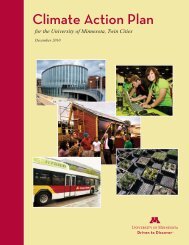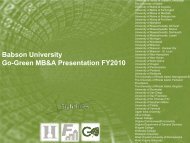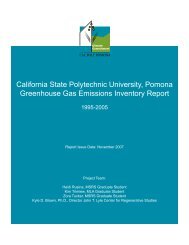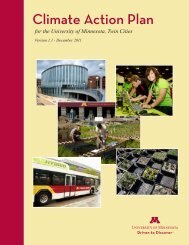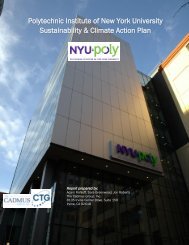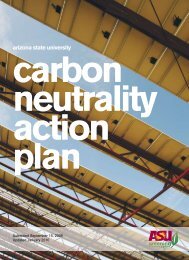Climate Action Plan - Binghamton University
Climate Action Plan - Binghamton University
Climate Action Plan - Binghamton University
You also want an ePaper? Increase the reach of your titles
YUMPU automatically turns print PDFs into web optimized ePapers that Google loves.
SECTION 4 – GREENHOUSE GAS MITIGATION STRATEGIESPHILOSOPHY<strong>Binghamton</strong> <strong>University</strong> has been successful in capping and gradually reducing its greenhouse gasemissions over the past decade. To achieve climate neutrality, however, will require afundamental change in the energy sources it utilizes as well as in human behavior. To maintainaccountability for our own actions, the <strong>University</strong> reserves the option of purchasing carbonoffsets or renewable energy credits (RECs) beyond what is required under Executive Order 111.President DeFleur maintains the philosophy that, in order for the greenhouse gas reduction tobecome permanent, it is critical for the campus community to participate in this effort.Cost-effectiveness is also a key factor in determining the feasibility of emission-reductionstrategies. After picking most of the ―low-hanging fruit‖ that have less than five years ofeconomic payback period, there will be a diminishing return on remaining energy conservationand renewable energy projects. If and when the proposed cap-and-trade greenhouse emissionsmarket structure is implemented at the federal level, a value can be assigned to each ton of GHGreduced, therefore improving the project return.Finally, ACUPCC urges colleges and universities to achieve the end goal while adhering to foursustainability principals by:1. eliminating our contribution to systematic increases in concentration of substances from theearth's crust in natural systems (such as fossilized carbon, scarce metals like mercury, etc.);2. eliminating our contribution to systematic increases in concentration of substances producedby society in natural systems (such as toxic chemicals, CFCs, etc.);3. eliminating our contribution to systematic degradation of natural systems by physical means(such as deforestation, erosion, flooding, etc.); and4. eliminating our contribution to the systematic undermining of people's capacity to meet theirneeds worldwide (such as supporting companies with unfair labor practices, perpetuatingpolicies that create barriers to escaping poverty, etc.).SETTING A TARGET DATE FOR CAMPUS CLIMATE NEUTRALITYThe Intergovernmental Panel for <strong>Climate</strong> Change (IPCC) projects that global GHG emissionsneed to be reduced 50 percent to 85 percent below the 2000 level by 2050 to avoid (a highprobability of) catastrophic impacts due to global warming. President DeFleur believes that thisis a critical target date toward which the <strong>University</strong> must work to achieve climate neutrality.Intermediate target dates are also established in this <strong>Climate</strong> <strong>Action</strong> <strong>Plan</strong> to monitor projectspecific progress.MITIGATION STRATEGIESOur solutions are focused on our already identified three largest greenhouse gas contributors:purchased electricity, on-campus boilers burning fossil fuels, and campus commute.~ 18 ~




